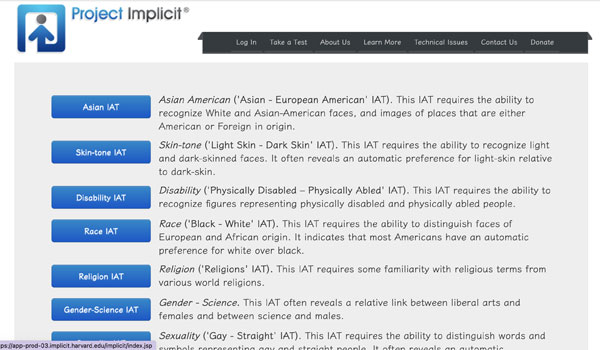The Harvard Implicit Bias Test provided an insight to the common bias in society

[A screenshot of the homepage of the Harvard Implicit Bias Project, Photo Credit to Jian Kim]
A proper member of our society should recognize it is impossible to be completely free of stereotypes or biases, although not in a manner in which he or she does not make an effort to rid themselves of their misconceptions.
However, even those aware that they hold stereotypes tend to naturally form a stereotype in their brain that they do not even recognize they possess.
Recognizing these “hidden stereotypes” though is extremely difficult, especially by just oneself.
At around five AM in the morning, I arrived in Korea, at Incheon Airport, after a grueling 15-hour flight from New York.
Prior to the flight, I had stayed for a one-month Enrichment Program at a boarding school in Hartford, Connecticut.
During the four weeks on campus, I was enrolled in a total of four courses, two of which were fundamental writing courses, and the other two were electives that I selected myself -- “Intro to Social Psychology” and “Forensic Science.”
Although I was taught the basics of forensics, and they were of my interest, upon learning about Social Psychology, I came across multiple studies that piqued my interest even more.
One of these studies was the Harvard Implicit Bias Test, which was, as implied by its name, conducted by Harvard University.
People can easily access this survey by simply typing implicit.harvard.edu into any search engine, which will take them to a page where they can select a certain type of survey.
There is a long list of available surveys, which includes the Asian IAT, skin tone IAT, and many more.
The primary goal of all tests was to indicate the social biases that are not so prevalent in society and aimed to analyze and present the biases we hold even without us recognizing that they exist in our minds ourselves.
Specifically for the survey I selected, Asian IAT, the purpose, as stated on the homepage, was to examine “the ability to recognize White and Asian-American faces, and images of places that are either American or Foreign in origin.”
At the beginning of the test (and the same for every other test listed on the site), data is collected on the client’s ethnicity, race, gender, and more to be used when analyzing the results of the client’s responses in the following principal part of the survey.
In the main section of the Asian IAT test, I was asked to categorize a face as either Asian American or European American using my keyboard, with the letters “E” and “I” accordingly as fast as I could.
In the next section, I was asked to categorize a foreign place versus an American place using my keyboard, with the letters “E” and “I” accordingly as fast as I could; for instance, I would be shown a picture of the Empire State Building.
Then I would be told to press the letter “E” if the picture shown is an Asian American person or an American place, but to press “I” if the picture shown is a European American person or a foreign place as quickly as possible.
In the next part, I was told to press “E” if the picture shown is an Asian American person or a foreign place, and to press “I” if the picture shown is a European American person or an American place.
When I was done with the survey, the website provided a detailed graph that showed the responses of other participants, and there were clear differences depending on the participants’ age, race, or ethnicity.
When our social psychology teacher debriefed this survey afterward, we were told that the aim of this survey was to show individuals the biases we hold that oftentimes we do not even recognize in ourselves.
Throughout this test, I realized that although I considered myself quite open-minded in regards to ethnicities, and even though I myself was an Asian American, I held certain stereotypes towards Asian Americans and European Americans and gauged, to some extent, European Americans as more “American” than Asian Americans.
Although this test was first released several decades ago (1998), it is still open for participants and continues to display data that raises awareness of the common biases that appear in our lives.

- Jian Kim / Grade 7 Session 2
- Chadwick International School

![THE HERALD STUDENT REPORTERS [US]](/assets/images/logo_student_us.png)
![THE HERALD STUDENT REPORTERS [Canada]](/assets/images/logo_student_ca.png)
